

Explore the history, culture, people and beautiful landscapes of Vietnam on the 63Stravel travel app
Download the 63stravel app

(Construction) - Ha Long City is known domestically and internationally as a semi-mountainous land - a beautiful coastal landscape, embracing a stone forest on the water with 1,969 islands of all shapes and sizes. Couple of chickens is a symbol of Ha Long Bay, but few people know about the twin mountains in Ha Long city with cultural deposits.
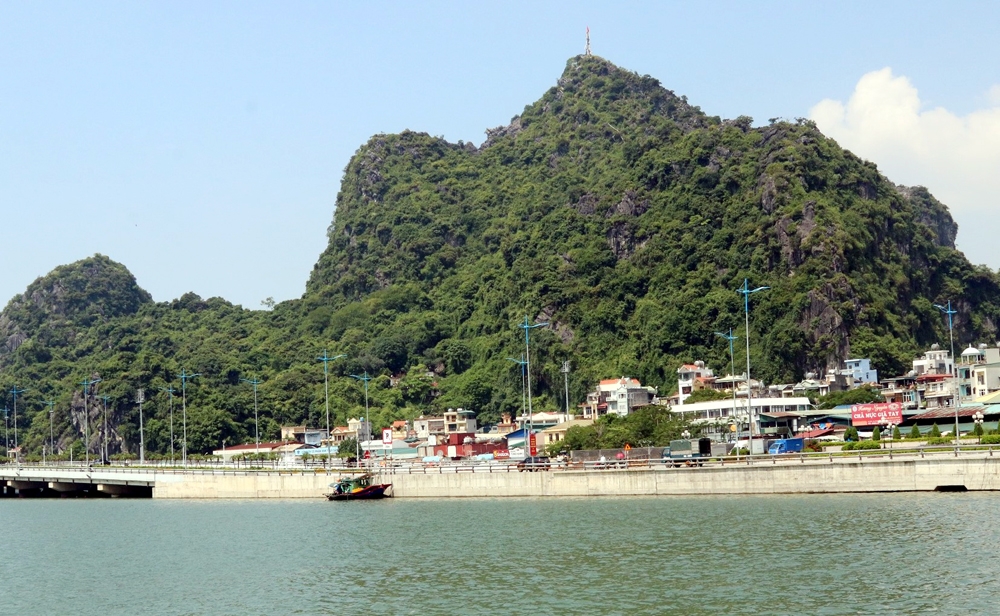
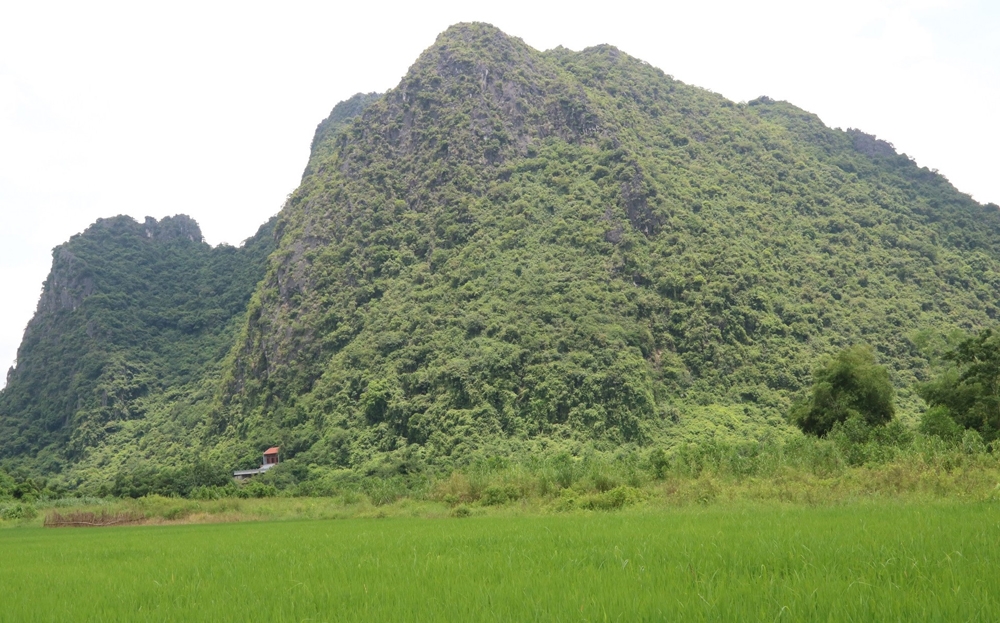
| Núi Bài Thơ và núi Mằn Sơn, truyền tục là cặp núi song sinh, nom địa mạo khá giống nhau. Theo các nhà khoa học, 2 quả núi cùng hình thành một thời điểm trong thời kỳ địa chất thứ II. |
That is, Bai Tho mountain and Man Son mountain. Bai Tho Mountain is located in Bach Dang and Hong Gai wards, Man Son Mountain is in Thong Nhat commune. This mountain is on the North bank, the other is on the South bank of Cua Luc Bay, 12.6km apart. The two mountains have a common feature: they are large limestone mountains and isolated from neighboring rocky mountains; has quite similar geomorphology, minerals, and vegetation. According to scientists, these two mountains were born at the same time during the second geological period.
Legend has it that at the beginning of the wilderness, the Jade Emperor sent angels to patch up the tears between heaven and earth. The angel carrying stones and patching up the sky has a huge body, mortals call him a giant. One day, when the giant changed roles, his burden was broken, one stick fell to the edge of the sea now called Bai Tho Mountain, and the other stick fell to the edge of the forest at the foot of the Thien Son mountain range "five tigers sitting on mountains" in the Northeast ( The 5 mountains over 1,000m high in the Dong Trieu arc are now called Man Mountain.
The twin mountains have an inseparable relationship with the giant's footprints left on the ground. Legend has it that Cua Luc Bay is 17m deep, has a water surface area of 18km2, and the water surface between Bai Tho Mountain and Man Mountain is the giant's footprint. Xich Tho village, Thong Nhat commune, bordering the northern shore of Cua Luc bay, today local people still say that there are two giant footprints on the pine hill, called giant mountain and giant footprint. The low land shaped like a human foot here is about 1 acres wide. During the subsidy period, people planted crops there and it was called giant field.
Bai Tho Mountain
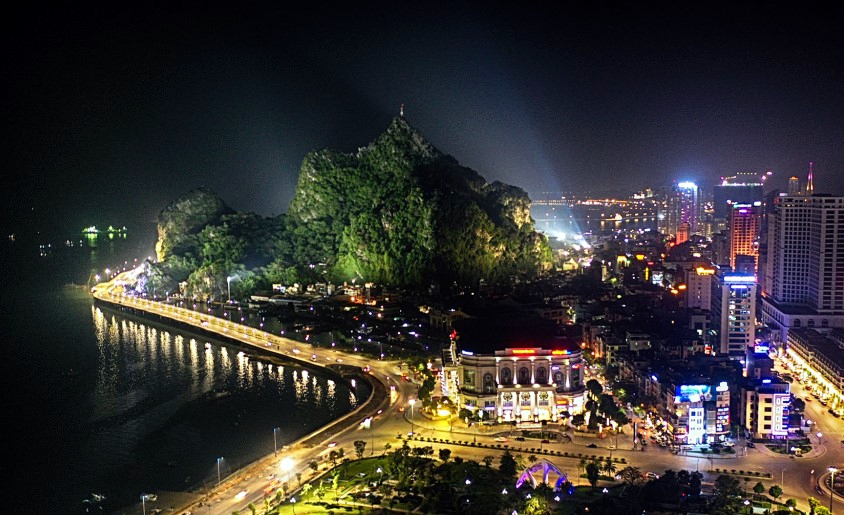
Bai Tho Mountain is located in the urban center of Ha Long city. In 1992, it was ranked as a national historical and scenic relic.
Bai Tho Mountain is 198.2m high, has a base area of 22.9ha, and the old area is Truyen Dang Mountain. In the past, fishermen and merchant ships called the lighthouse Truyen Dang, now it is Hai Dang, a signal light for boats and ships traveling in the Northeast sea. In 1468, King Le Thanh Tong patrolled the waters of An Bang, arriving at the foot of Truyen Dang mountain, a calm sea with green water, emerging a tall, isolated mountain with breathtaking scenery. The king turned the scene into poetry and had someone carve it into the cliff. Next, there are 11 poems written by mandarins of later feudal dynasties and other people and guests who also carved poems on Truyen Dang cliffs. The mountain has many poems, the greatest being the poem of King Le Thanh Tong, the locals used to call it De Tho mountain, then gradually called Bai Tho mountain.
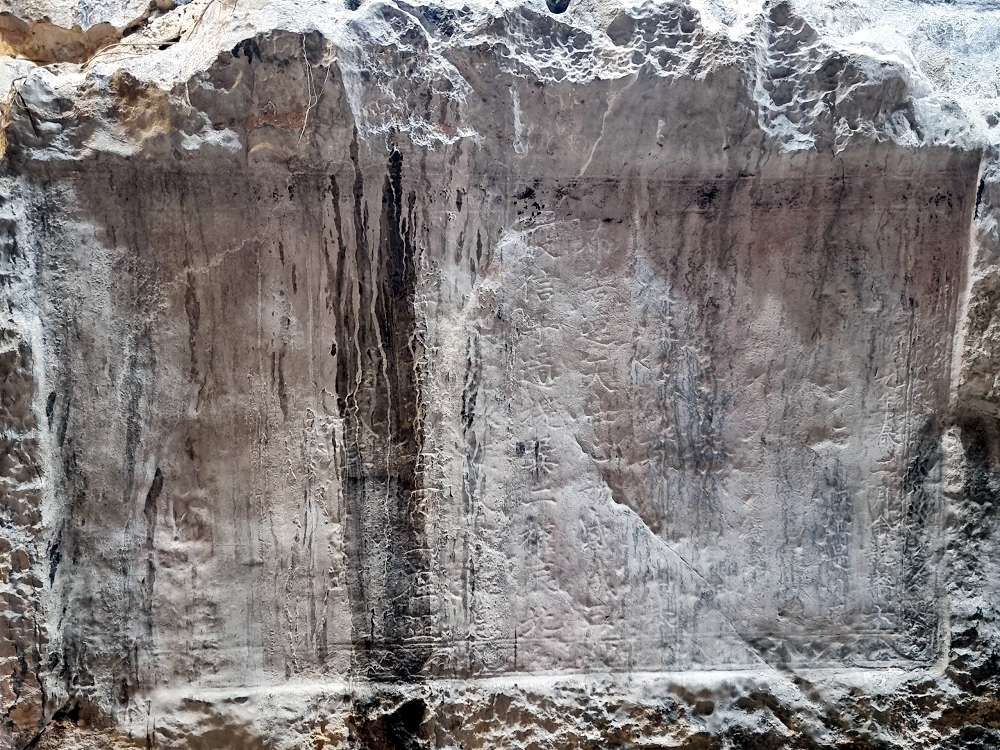
Poem by King Le Thanh Tong with 56 Chinese characters, carved into a cliff about 6m above tide level.
The poem by King Le Thanh Tong was carved into the mountainside in the south and is the oldest poem and has the most historical and cultural value. The poem has 56 Chinese characters, carved into a rectangular hollow cliff, about 6m above tide level.
After King Le Thanh Tong, many poets carved poems into Truyen Dang mountain. The poem by An Do Vuong Trinh Cuong was engraved in 1729, depicting a poem by King Le Thanh Tong. In 1910, Quang Yen Governor Nguyen Can engraved an article; In the same year, the judge brothers Vu Tuan and Vu Dai each engraved two poems, Vu Dai's wife, Dao Thi Thoa, had a poem in the national language. In 1929, officials Hong Lo Tu Khanh and Nguyen Van Ban engraved an article; In 1935, the Tuan Phu mandarin of Quang Yen province, Nguyen Van Dao, engraved a poem. On Truyen Dang Mountain, there are two more poems carved into rocks around the 40s of the 20th century. The preface and content of the poems are mainly about natural beauty, the spirit of the Tran dynasty, and the prosperity of the Le dynasty.
Bai Tho Mountain is also a historical relic marking the milestones of the army and people of Ha Long city during the struggle against the French colonialists and American imperialists. On the night of April 30, 1930, patriotic miner Dao Van Tuat climbed Bai Tho mountain to hang the Party flag at Mo Qua tip. On the morning of May 1, 1930, the red hammer and sickle flag flew on Bai Tho Mountain in broad daylight, affirming the revolutionary fighting spirit of the miners in the coal region, making the French colonialists extremely frightened at that time.
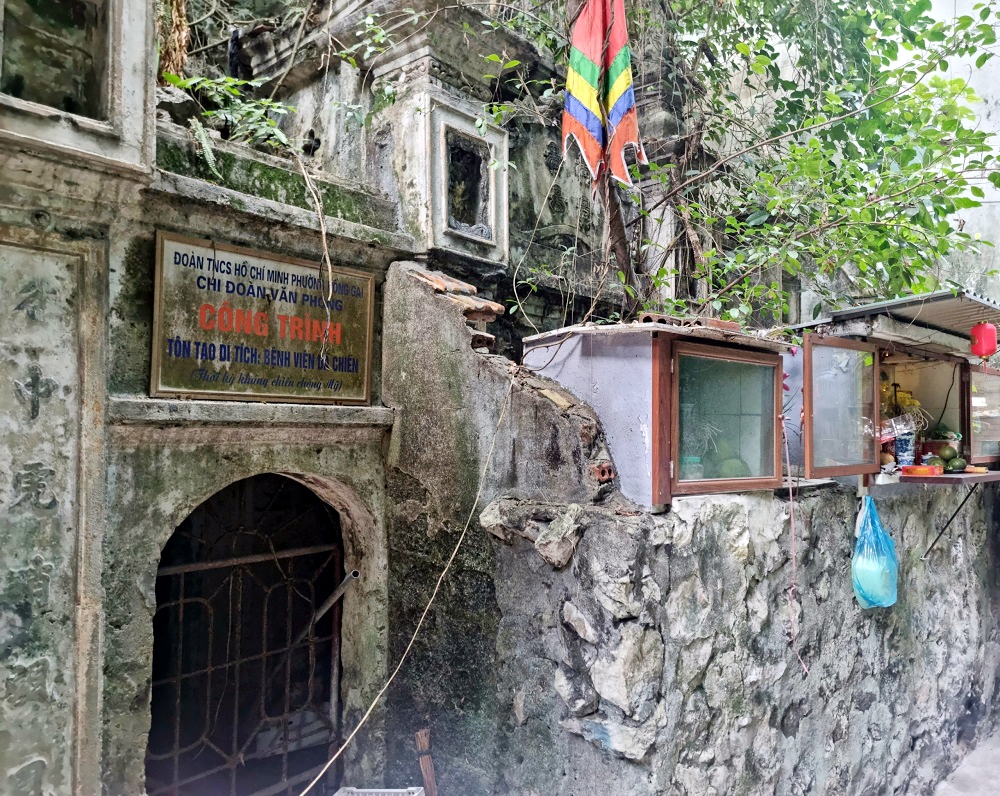
Cave No. 6 relic is currently managed by the Hong Gai Ward Youth Union.
During the resistance war against America, Bai Tho Mountain also recorded many historical marks. During the first American air attack, on the Mo Qua cliff, a loudspeaker was placed that was transferred from a cluster of high-power speakers on the northern bank of Hien Luong Bridge - 17th parallel to signal air defense orders and an observatory for enemy aircraft. from far away. The caves inside the mountain are different in width and narrow, called from cave No. 1 to cave No. 6. During war, the caves in the mountain are used to hide from bombs, postal information stations, radio stations, etc. Cave number 6 is large, containing the emergency department of the provincial hospital.
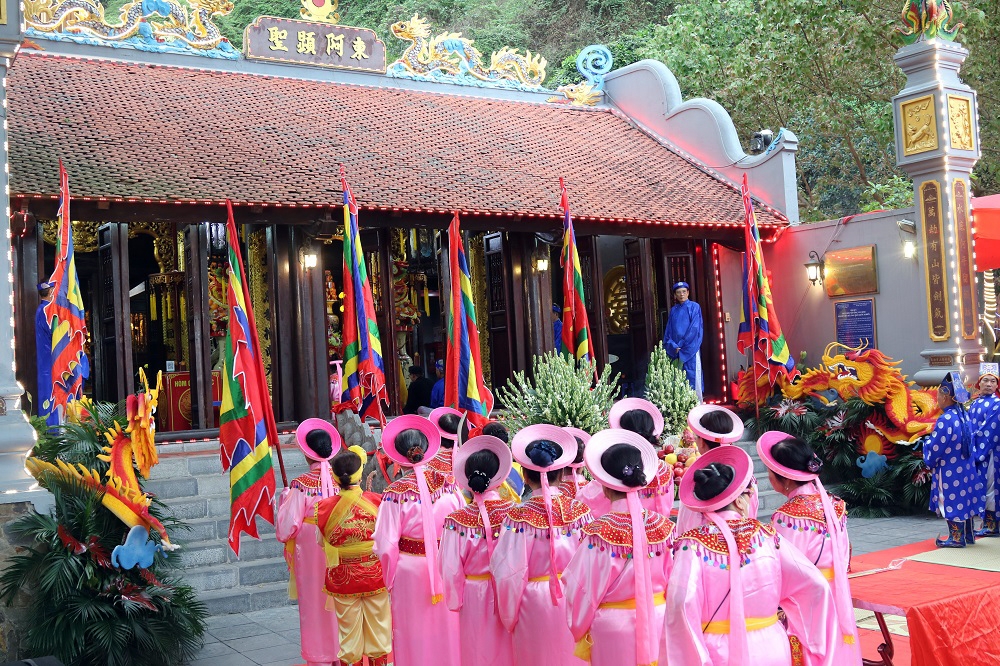
The temple festival of Monsignor Tran Quoc Nghien was restored and held on April 29 and 30 in association with the annual Ha Long Tourism Week.
There are many species of plants on the mountain, including some beautiful flowers such as orchids, sycamores, bamboo, and wild golden monkeys still live. At the foot of Bai Tho mountain in the north is Long Tien pagoda, the largest and most beautiful pagoda in Ha Long city; At the foot of the western mountain there is a sacred temple worshiping Hung Vu Vuong Tran Quoc Nghien. The Bai Tho Mountain - Long Tien Pagoda relic cluster was ranked a national historical and scenic relic by the Ministry of Culture, Sports and Tourism in 1992.
Mountain
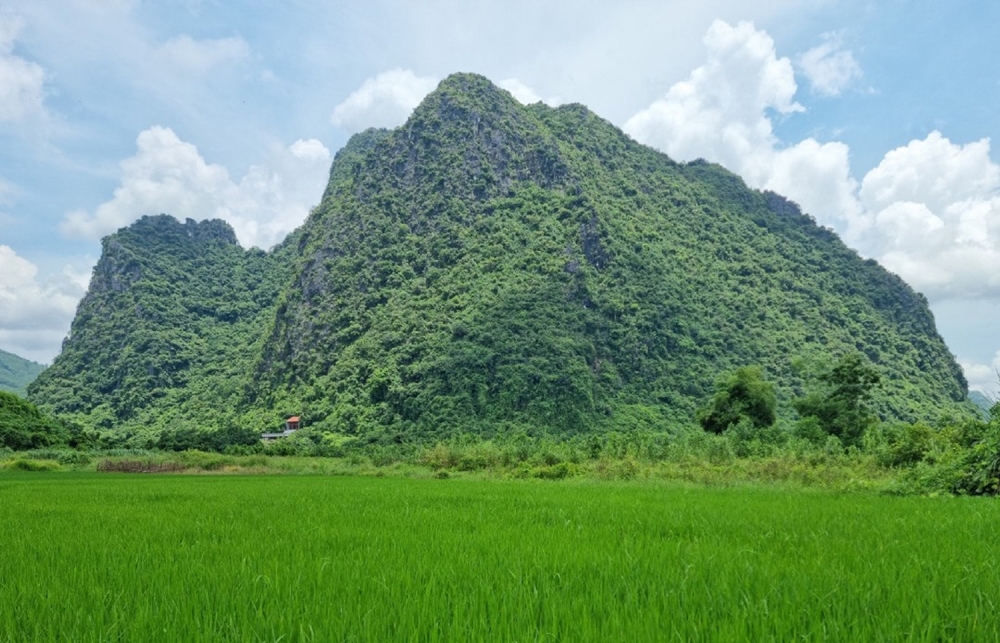 Núi Mằn ở thôn Đá Trắng, xã Thống Nhất.
Núi Mằn ở thôn Đá Trắng, xã Thống Nhất.
Man Mountain is 381.8m high, has a bottom area of 383ha, located between two streams, Da Trang stream and Luong Ky stream, which flow into Cua Luc bay. Man Mountain was also known as Ban Mountain in the past, a beautiful and typical mountain for the terrestrial limestone mountain system of Ha Long city.
In fairy tales and legends, the name "Multiple mountains and seas, ten thousand great kings" has been recorded. According to Dong Khanh's geographical journal page 406, the National History Office of the Nguyen Dynasty compiled in 1886-1888, Hoanh Bo land, now Ha Long city, had many beautiful rocky mountains at that time such as: Ban Mountain, Truyen Dang Mountain, Hap Mountain, Phuong Cac mountain... But there were only two famous mountains ranked as Famous Sons at that time: Man mountain and Truyen Dang mountain. Historians say that Man Mountain was once the headquarters of the Ly Dynasty army during the resistance war against the Song Dynasty in the 11th century. During the Tran Dynasty, during the two resistance wars against the Yuan-Mongol invaders (1285, 1288), Man Mountain was chosen by Hung Dao king Tran Quoc Tuan as the strategic reserve headquarters of the naval army. After winning the Bach Dang battle in 1288, King Tran Thanh Tong gathered his troops at Man Mountain and set up an altar to worship the gods. Mount Man is a mountain river acupuncture point, in the Northeast region, a place of prosperity.
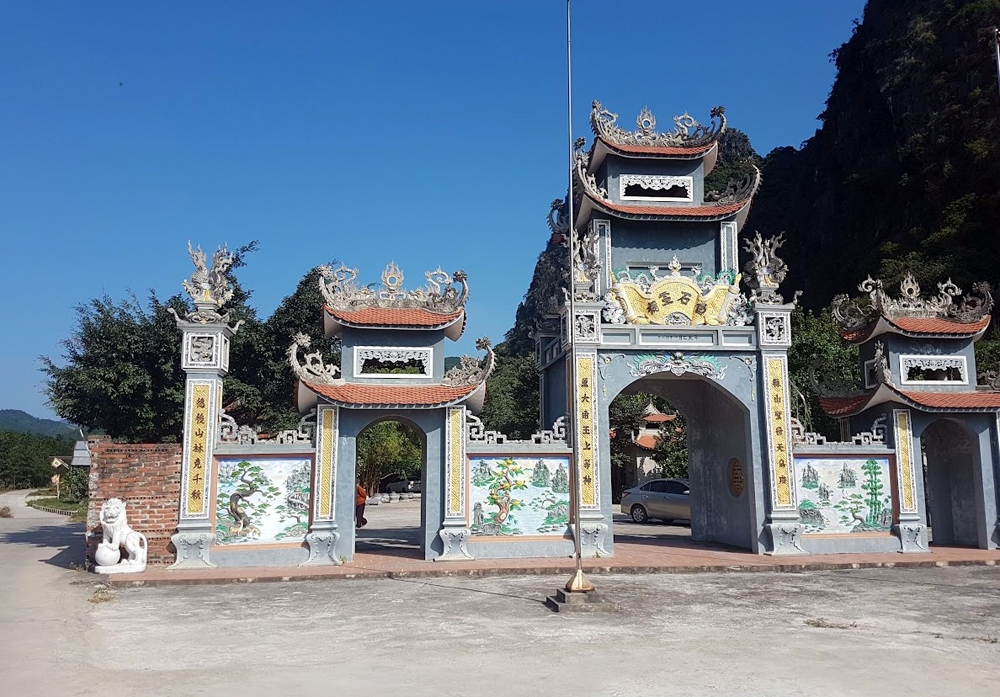
Bach Thach Linh Tu, worships the only Taoist religion in Vietnam.
At the foot of Man Mountain there is a sacred ancient temple, which the locals simply call the White Stone Temple, and the literal name is Bach Thach Linh Tu. Temple of the Supreme Immortal Taoist; Many localities of Thuong Tien Taoism have established shrines and temples, but they mainly worship worship. Bach Thach Temple, in particular, worships the main Daoist gods, is a unique feature in Vietnam. Bach Thach is compassionate, the harem worships a statue of a goddess made of monolithic white stone weighing over 1 ton, sitting on a dragon throne, sitting in the double position, with a compassionate and pure facial expression. According to legend, the ancient god who guarded the Bach Ngoc Kinh in the sky and Man Son was honored with the title Thien Cung Thuong Tien, old mother of Man Son, and Lady Bach Ngoc. Bach Thach's spirit, when the three religions were of the same origin, they worshiped the Council of the Four Palaces, the Jade Emperor, the Tam Thanh and the Buddhist temple.
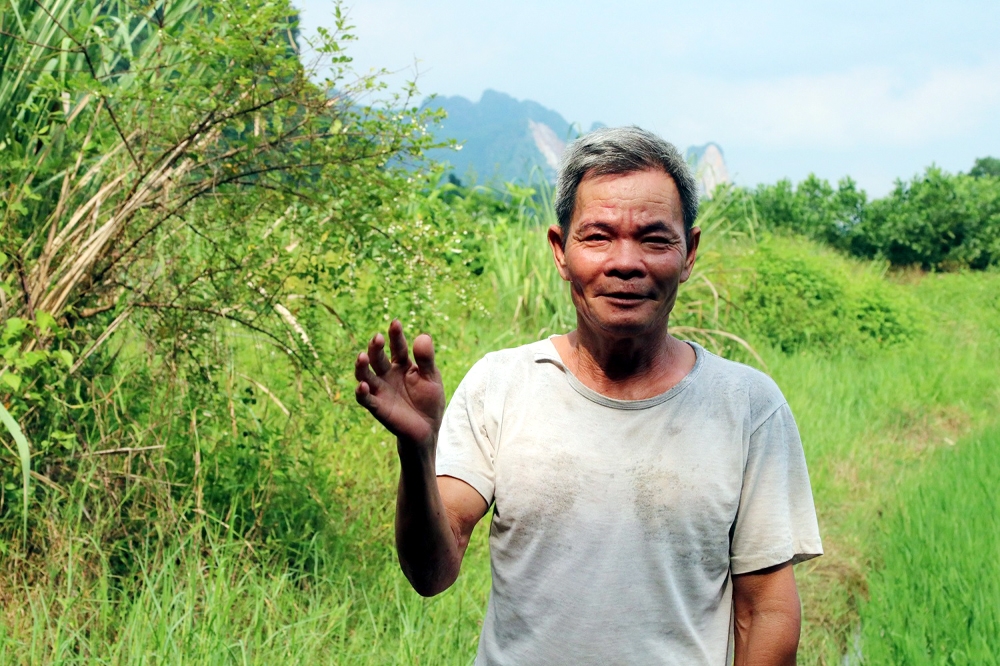
Mr. Trinh Van Khoa, a long-time resident of Da Trang village, said that on Man mountain there is a large square rock shaped into a strange chandelier. The elders said that it was a tent from the heavens, the lid was kept on Bai Tho mountain.
In the field, halfway up Man Mountain, there are natural rocks with strange shapes, with the top bulging out to be large and the bottom constricting into a small mushroom-like shape called hat rim rocks. There is a box-shaped rock with square edges and an old man's heart that says it is a chandelier, a chandelier built on Bai Tho Mountain (Poi Tho Mountain also has a square stone slab as legend has it). This strangeness is related to the idiom "old snakes shed their skins, old people fall into their shells". On the east side of the mountain there is a large stone cave called Buddha cave, inside the cave there are ruins of an ancient worshiping temple, because on the ceiling of the cave, under a layer of faint moss, there are ancient Chinese characters, roughly translated as Son Than Tu and fragments of ancient worshiping objects, Deep inside the cave, the stalactites are still pristine and shimmer when they catch the light.
The saddle points halfway up the mountain, with many low-lying areas where water collects and crystal clear water seeps out from between rocks, the locals call it Thien Be (or Heaven Well). Thien Be has four seasons of water: in the summer the water is cool, in the winter the water is warm and in the morning the water surface evaporates like a pan of boiling water. The rising steam mixed with the night mist rippled around the rocky outcrops, looking like waves playing in the sea. At the bottom of the water, shrimps swim and there are many mountain crabs and wild snails living. When they see movement, crabs as big as sea fiddler crabs rise up to defend themselves, looking funny and showing that the living environment on the back of Man Son mountain is very good.
It is very possible that people once lived on Man Mountain. Some scholars researched the history of the museum, where Son Vi - Dong Son cultural deposits were located; In the cave there are many fossilized marine flora. Legend has it that Man Mountain used to be a place of refuge to avoid the enemy and to avoid being hunted when soldiers and swords succeeded the royal court, which often happened in feudal dynasties. Because traces of ancient Chinese characters, fragments of ancient terracotta utensils, shells and tangerine trees appear to have been planted, there are still traces left on the ceiling of the cave. Man mountain tangerine, the tree grows on rocks but is green and bears fruit. When tangerines ripen, many patches of forest are golden. In the past, shepherd children still picked them, but now ripe tangerines are falling from the trees, only to serve as prey for wild animals.
Man Mountain has a rich and diverse flora very similar to Bai Tho Mountain, but far from urban areas there are more trees and wild animals. The patch of land interspersed with rocks has many species of precious medicinal plants, cymbidiums and wild animals such as: antelopes, golden monkeys, monitor lizards, geckos, pheasants, peacocks... The Man mountain relic cluster is recognized by the Ministry of Culture - Sports and Tourism ranked national historical and scenic relics in 2014.
Luc Gate
Cua Luc Bay, with a water area of 18km2 and a depth of 17m, is the connection center between Ha Long city and Hoanh Bo district when the two localities merged into one, taking the common name Ha Long city. Cua Luc Bay has a similar relationship with Man Mountain and Bai Tho Mountain. Legend has it that Cua Luc Bay is the footprint of a giant carrying rocks to the sky. When he changed shoulders, one of the rocks fell into the sea, Bai Tho Mountain, and the other rock fell into the forest, Man Mountain.
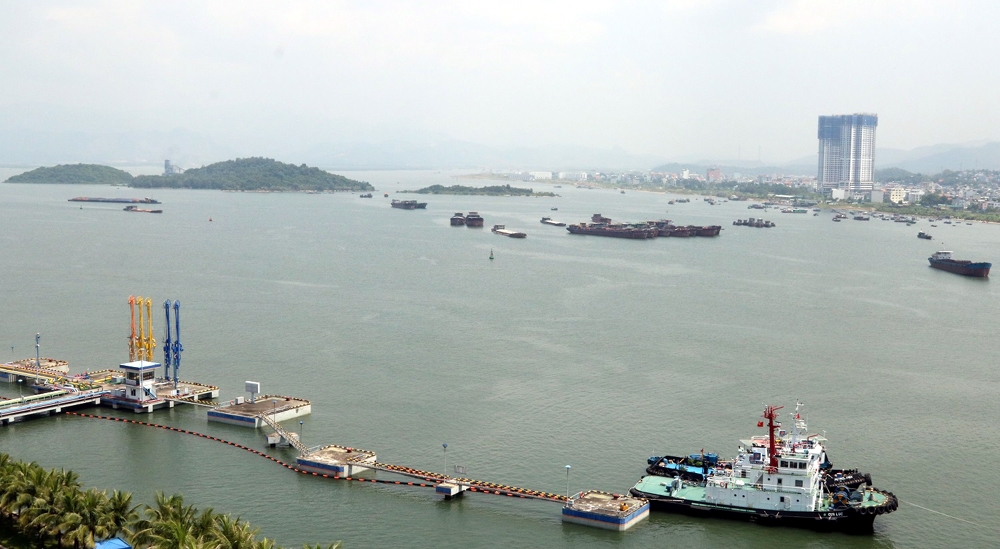
Cua Luc Bay used to be an ancient seaport cluster with Gao Rang wharf and Dong wharf; On the wharf is the Mac Dynasty citadel.
Vinh Cua Luc also has different opinions, some say it is the confluence of 6 rivers, but some say it is completely different from Luc Dau Giang in Hai Duong province. Cua Luc Bay, above is the roof of mountains, streams and forests falling straight down, without alluvium, the clear green forest water mixes with the same clear blue sea water. At the estuary, the clear blue water is called Cua Luc. Today's Cua Luc Bay was originally a strait with three navigable channels. The main gate is Cua Luc, the pair of armpit doors are Hon Hai gate and Kenh Dong gate. Inside the bay is a cluster of ancient seaports with Gao Rang wharf, Dong wharf... belonging to Van Yen, Tri Xuyen, Bang Troi cantons.
On July 26, 1884, mandarin Pham Than Duat, on behalf of the Hue court, signed a 100-year coal mine lease to French capitalists. The French colonialists created a land concession map, at that time the Bai Chay - Hon Gai area was an island, boats from Hon Hai (Hong Hai ward) entered Cua Luc bay to Dong Kenh (Geng Day ward). Bai Tho Mountain and Ba Deo Mountain were both islands at that time. Hung Thang Island and Sa To Island have recently become mainland.
Cua Luc is mentioned in the history of the classic naval battle of Van Don - Luc Thuy, where General Tran Khanh Du of the Tran Dynasty sank 600 warships of the Nguyen - Mongol invaders in 1288 in the Northeastern sea. Autographs in two poems engraved on Bai Tho mountain, written by mandarin Hong Lo Tu Khanh Nguyen Van Ban in 1929 titled "Cruising on a boat to visit the Six Seas..."; The article "Going to Luc Hai to sail..." engraved in 1935 by Quang Yen Governor Nguyen Van Dao, further cemented Cua Luc as a sea gate with clear blue water.
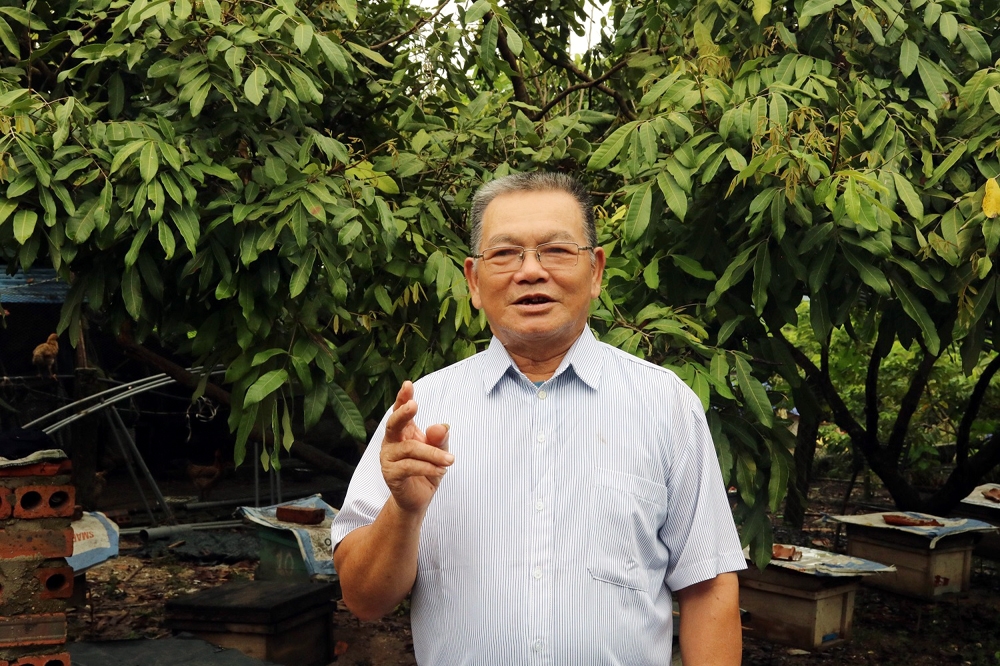
Mr. Tran Van Nghi from Xich Tho village said that the person whose body can carry Bai Tho Mountain and Man Mountain must have feet as big as Cuu Luc Bay, but the legend is just a myth.
Cua Luc Bay is the footprint of a giant. There is also another legend, saying that the giant carried a rock and patched the sky when passing Cua Luc Bay. He turned his shoulder and broke his burden, falling into the sea to form Bai Tho Mountain, falling into the forest. into Man Mountain. The giant also left two footprints on the hill in Xich Tho village. The footprints were about an inch into the ground. People who farmed in that low land called it giant field or giant hill. But Mr. Tran Van Nghi, who was born in Xich Tho village and worked as head of the commune's Cultural Committee for 10 years, said that legend says that a person whose body can carry Bai Tho and Man mountains must have feet as big as Cuu Bay. Green.
Bai Tho Mountain - Man Mountain, the twin mountains and Cua Luc Bay - Tam Da are also associated with a series of legends about the giant carrying stones and patching the sky, leaving footprints on the hill. A mountain girl working in the fields, accidentally set foot in the nursery and got pregnant, then gave birth to 3 giant snake gods: Mr. Coc, Mr. Dai, Mr. Loan... with thrilling stories. Currently in the locality, there is still a tradition of worshiping three separate snake gods. Mr. Coc is worshiped in the cave field, Mr. Loang is worshiped in the bronze cave, Mr. Long is worshiped in white stone.
Bai Tho Mountain and Man Mountain in Ha Long city have a project to exploit landscape-eco-tourism. Cua Luc Bay, according to the general planning of Ha Long city until 2040, approved by the Prime Minister, the central urban area of Quang Ninh province will develop according to a model of 5 regions; in which, taking Cua Luc Bay as the center connecting socio-economic infrastructure. Currently, the port cluster in Cua Luc Bay, including: Quang Ninh Port, CICT Container port, B12 petroleum port, Ha Khanh coal port... is accounting for a high proportion in the revenue structure of Quang Ninh.
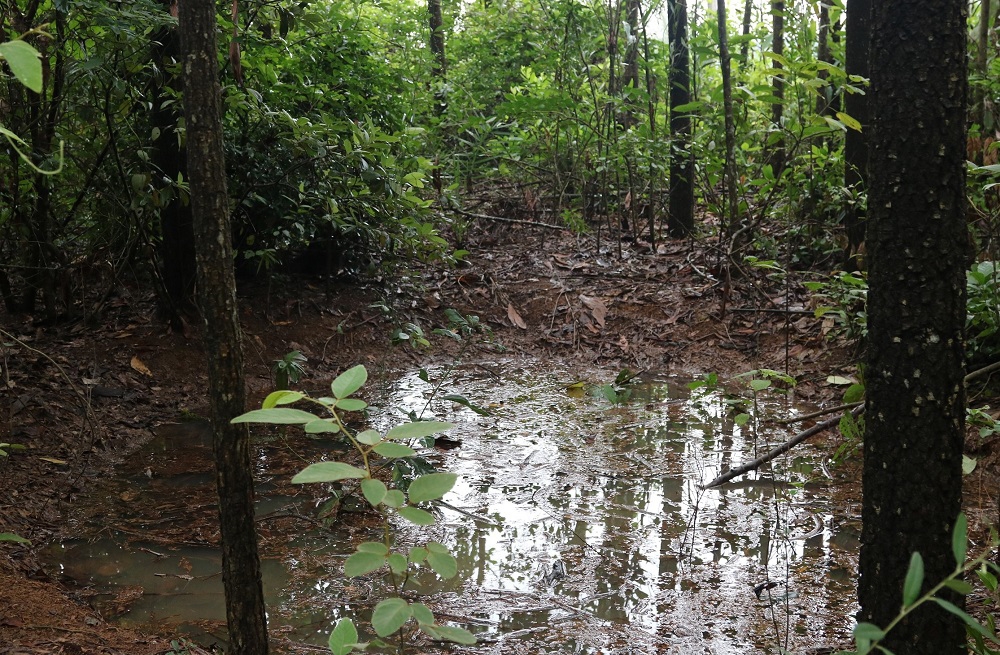
His giant footprints on the hill in Xich Tho village used to be as wide as a field, but now they are the size of a buffalo puddle.
Quang Ninh 1946 view
Update day : 05/11/2023
Ha Long city, Quang Ninh province, about 180 km from Hanoi, is known as the tourist paradise of the North. With a convenient location, modern infrastructure and developed transportation system, Ha Long city attracts tens of millions of domestic and foreign tourists each year. Ha Long Bay has an area of 1,553 square kilometers including 1,900 large and small limestone islands with vivid shapes. The bay has been honored many times by UNESCO as a world natural wonder and is a tourist destination not to be missed. The weather in Ha Long is divided into two distinct seasons: summer - from May to October and winter - from November to the end of April. The average annual temperature is 25ºC, quite ideal for sightseeing trips. outdoor view. With diverse vegetation and favorable climate, you can travel to Ha Long Bay at any time of the year. However, according to experience traveling to Ha Long Bay, you should avoid stormy times in July and August to have the most complete trip. Regarding travel costs from Hanoi to Ha Long city or Ho Chi Minh City. Ho Chi Minh to Ha Long, you can refer to below: Regarding accommodation costs, depending on the area you choose, the room price will have a certain difference. Ha Long room prices usually range from 200,000 VND/night to 2,000,000 VND/night. Food costs also depend on the number of dishes you order, and the number of people eating. However, in general, the cost per meal is not too high. If you eat seafood in a restaurant, the cost is from 150,000 - 500,000 VND/person. The cost to visit Ha Long Bay is about 250,000 VND - 2,000,000 VND depending on the type of tour you choose. Normally, people who have experience traveling to Ha Long Bay on their own will choose to visit the bay by boat for 250,000 VND/person. It can be seen that the cost for a trip to Ha Long Bay is not fixed but depends on the individual's schedule and entertainment needs of each tourist. However, if you choose to travel on your own, the most suitable cost to eat, rest and visit places for about 2 days will range from 3,000,000 VND to 5,000,000 VND. According to Ha Long Bay travel experience, there are many convenient means of transportation to visit every corner of Ha Long city: Motorbike: You can easily rent a motorbike to explore Ha Long city by yourself at a reasonable price. However, for many tourists, you should ask in advance the car rental price and remember the time to return the car to avoid "unjustly losing money". Bus: Ha Long has a bus system connecting famous tourist destinations. The average bus ticket price in Ha Long city is about 7,000 - 10,000 VND/way. Electric vehicle: Electric vehicle is quite a popular means of transportation, especially in the center and tourist destinations in Ha Long. According to Ha Long Bay travel experience, the price of a tram ticket is about 500,000 - 900,000 VND for one trip. You can use this service from 7:00 a.m. to 10:00 p.m. every day. Taxi: This is a convenient means of transportation and suitable for most tourists. Tourist destinations in Ha Long Bay are not far from each other so the cost of traveling by taxi is not a problem. Taxi prices in Ha Long Bay range from 5,000 - 11,000 VND/km, depending on the car company and distance traveled. Ha Long Bay has majestic and poetic natural beauty with thousands of large and small islands and many unique caves. The bay is also recognized by UNESCO as a world natural wonder and attracts a large number of tourists every year. When going around the bay, you can admire beautiful natural scenery with beautiful destinations such as Sung Sot cave, Con Coc island, Dragon Eye island, Ti Top island, Ngoc Vung island,... Bai Chay Beach is an artificial beach located next to Ha Long Bay. This is the most beautiful beach in the city, with clear blue water and fine white sand stretching nearly 1,000 meters. According to Ha Long Bay travel experience, you can freely swim, check in and experience water games. Located on Tuan Chau island, Tuan Chau tourist area attracts tourists with its beautifully decorated and poetic space. When coming to Tuan Chau, you should attend a water music performance and have fun at the outdoor amusement park or the newly opened dinosaur park. Kayaking leisurely on the cool water, hidden behind the Luong cave mountain range will make you feel extremely peaceful. After visiting Luong cave, you can walk to Ti Top island and watch the sunset with friends on a yacht. Quang Ninh Museum is considered a miniature model of Quang Ninh province, a place that preserves the culture and peaceful life of Ha Long people. Young people traveling to Quang Ninh all have "lifetime" photos at this attraction.
Quang Ninh 2203 view
May to October
Tuan Chau Island is a super famous tourist resort destination in Ha Long city, Quang Ninh. Located about 2km from Ha Long city center, the island has an area of about 400 hectares with many beautiful landscapes, beaches, and tourist areas for tourists to visit. Tuan Chau Island is a super famous tourist resort destination in Ha Long city, Quang Ninh. Located about 2km from Ha Long city center, the island has an area of about 400 hectares with many beautiful landscapes, beaches, and tourist areas for tourists to visit. Tuan Chau Island is a beautiful beach tourist destination, so the ideal time to visit will definitely be in the summer. The time from March to October will be the most suitable time, at this time the sky is clear, the sea water is cool blue, the beach is white sand and the sunshine is extremely beautiful. However, you should note that the summer period from May to July will have very high temperatures, possibly up to 40 degrees Celsius. For those of you with weak health or families with children and the elderly, remember to be careful. kidney. When traveling in the summer, don't forget to bring sun protection items for yourself. Coming to Tuan Chau island, you can participate in activities such as swimming. Swimming is definitely always the first activity when coming to Tuan Chau island area. With a super beautiful artificial beach of up to 5km, fine white sand, cool blue sea water, Tuan Chau beach will definitely be a great medicine to forget daily fatigue. You can immediately dive into the cool ocean water, freely swim or participate in exciting activities. In addition, you can participate in the Tuan Chau water music program. Tuan Chau Island Water Music Performance Palace is a venue for many water music shows combined with extremely spectacular lighting. This place is designed with very special architecture inspired by the Roman school. The area of the Water Palace is 15 hectares with 12,000 seats. The programs here are very professionally invested, on average a performance will last about 40 minutes. And there are many other attractive activities.
Quang Ninh 1940 view
From April to December
Co To is an archipelago of about 50 islands located in the east of Quang Ninh province with an area of 46.2 km². Co To island district currently has 1,500 households, with nearly 6,000 people. The Co To archipelago has more than 50 islands, large and small rocks, of which Big Co To and Small Co To are the two islands with the most beautiful beaches. This is also a place with great potential for tourism development. Coming to Co To, you can visit the following places. First, Cau My Stone Beach. This is a place known as the paradise of love and youth amid the waves of Co To. The entire area is shaped like a mouse's tail, facing the sea, located south of Co To Lon island. Cau My with its sedimentary rock system eroded over tens of thousands of years by sea water creates a unique wonder among the islands of Vietnam. In addition to the rocks, high points from which you can enjoy panoramic views of this landscape will definitely make you feel like you are in the Mediterranean. Next is Co To Lighthouse, located in the eastern archipelago of Van Don island, Quang Ninh province, located on a mountain about 5km from the town, the highest point of the island, built in the late 19th century. The road from the foot of the mountain to the lighthouse is winding under dense forest foliage, rows of purple myrtle flowers, and bumpy rocks on a rarely traveled trail. Co To lighthouse has a bright view of 118m above sea level. From here, looking far away, we can see far away the vast sea disappearing below the horizon, below are mountains, forests, and beaches. The clear blue water of the pearl island of Co To, captures the view of the dreamlike coastal town, interspersed with lush, green forests and humble and simple roofs. Visitors to Co To cannot miss this unique experience. Next, Co To Lon Island Church in Area 4, Cam Pha Parish, Hon Gai County, Hai Phong Diocese, inaugurated on May 28, 2013. This is the first church on the island built to serve the parishioners on the island. This church was built at the foot of a hill with a length of 26.7 m and a width of 9.8 m. Although this is a small church, it is the only church on the island, and is one of the attractions that tourists visit when traveling to Co To. Besides, there are some other great places such as: Hong Van Beach, Van Chay Beach, Thanh Lan Island, Co To Island. Like the beaches of other tourist destinations, on Co To Island you can buy fresh seafood the same morning you return. Fishermen on the island often bring newly caught seafood to sell at the pier for the convenience of tourists. The vendors will also box and ice the seafood for you so you can take it home without worrying about the seafood spoiling. In addition, in Co To there are many impressive souvenirs made from oysters, clam shells, and snails. You can absolutely choose those items for yourself as gifts.
Quang Ninh 2173 view
From March to October
Quan Lan Island is located on Bai Tu Long Bay, including Quan Lan commune and Minh Chau commune in Van Don district, Quang Ninh province. The entire island has an area of 11km2, stretching from the foot of Van Don mountain range to Got mountain with high mountains in the east like a strong wall blocking the waves to protect the island's residents. You can choose to travel to Quan Lan beach in summer or fall because this is the time when the weather is cool and favorable for you to have fun and relax. The period from April to June and from September to November is considered the best time to come to Quan Lan. Besides, you should also note that you should not go in July and August because this is the time when rainstorms often occur, which will affect the trip. The main means of transportation for tourists when coming to the island is the tuk tuk. Each bus can carry about 8-10 people, rushing along small roads to the beach. Normal price is about 100,000/trip. You can also rent a car to take you the whole journey for 2-3 days for about 500,000 VND. In addition, you can also rent a motorbike or ride a motorbike taxi to visit the island. However, motorbike taxi prices here are twice as expensive as on the mainland because gasoline on the island must be transported from the mainland, so you need to consider carefully. Quan Lan Island attracts tourists with beautiful beaches, fresh space, cool blue sea water and extremely quiet, not hustle and bustle like other beaches. Quan Lan has 3 beaches including Quan Lan beach, Minh Chau beach and Son Hao beach. Depending on the time and initial budget, you can choose to bring a camp or learn about the experience of renting a hotel to save maximum costs on your trip to Quan Lan. If you rent a motel or hotel, it is best to book a room in advance to avoid being charged high season prices. Food service in Quan Lan is not yet developed, so you should book in advance if you don't want to go hungry. You should also bring ready-made food and water because there is no fresh water on the island. Some famous types of seafood in Quan Lan are sea worms, geoducks, clams, co ky, cylindrical fish... these are specialties that you cannot miss when coming here.
Quang Ninh 1921 view
March to August
Tra Co Beach is one of the most beautiful coastlines in Quang Ninh with a length of up to 15km. Tra Co Beach is located about 8km from Mong Cai city and about 200km from Ha Long city. Tra Co is famous for its beautiful natural space, cool blue water and golden sand. Tra Co Beach is one of the most beautiful coastlines in Quang Ninh with a length of up to 15km. Tra Co Beach is located about 8km from Mong Cai city and about 200km from Ha Long city. Tra Co is famous for its beautiful natural space, cool blue water and golden sand. Beach tourism is definitely the best in summer. At Tra Co beach, the most ideal time will be from April to July. This time Tra Co beach will bring a super beautiful landscape with clear water, gentle waves, not too heavy, so it is very suitable. suitable for swimming. For those of you who want to experience the festivals at Tra Co beach, remember to come here between May 25 and June 6 of the lunar calendar. At this time, many interesting activities will take place such as the God Procession Ceremony, the Boat Procession Ceremony, the Elephant Procession Ceremony,... Visiting Tra Co beach, surely the first thing everyone wants to do is immerse themselves in the clear blue water of this place. Tra Co Beach makes a deep impression with its pristine scenery, blue sea water, and gentle waves throughout all seasons, making many tourists remember it forever. The beauty under the sea on the shore is even more wonderful, with fine white sand, many green casuarina trees or blue seaweed strips creating an extremely wonderful scene. In the early morning or late afternoon, Tra Co beach also entertains visitors with extremely beautiful sunrise and sunset views. At this time, you will clearly see Tra Co beach as if it is wearing a completely new coat. Especially the sunset scene, both brings mesmerizing beauty and creates a feeling of regret when admiring. Da Den Beach, also known as Ngoc Son beach, is a beach located quite close to Tra Co beach. As the name suggests, Da Den beach possesses many black rocks with diverse shapes from small to large. They lie next to each other on the sandy shore, creating a scene that is both mysterious and attractive. Besides, Da Den beach also has a smooth white sand beach, blue water and beautiful wild scenery. Coming here, you will also find super beautiful check-in corners.
Quang Ninh 1879 view
April to July
Coming to Quang Ninh tourism, no one knows that Bai Chay beach is an artificial beach with many extremely attractive beautiful scenes, attracting a large number of tourists during the beach tourism season. To help you have a fun and enjoyable trip that fits your budget, perhaps the article below will help you a lot. It is the widest beach in Ha Long city, attracting all the attention of tourists. The artificial coastline, stretching more than 1000m long and more than 100m wide, is blessed by nature with wonderful beauty with clear blue water and clean beaches, attracting a large number of tourists. Along the coast is an endless row of pine trees creating fresh, peaceful, relaxing air of sea breeze combined with green trees. All domestic and foreign tourists come here to not only visit, rest, relax, take photos, surf the web, read books on the beach with free wifi internet service, but also listen to TV shows. the heroic theory of fighting against foreign invaders of our ancestors. The characteristic of this coast is a strip of low hills running straight down to the sea, on both sides of the beach are rows of ancient pine trees and, in addition, there are lovely villas and famous Quang Ninh hotel chains. Coming to this place starts with a clear blue beach with a long stretch of white sand with rows of ancient trees on both sides, romantic sunsets and sunrises, creating comfort and peace for visitors. strangely. In addition, this place also serves bicycle rental on the beach, surfing cars, kite rental, and a variety of extremely unique dining services. Besides, Bai Chay Bridge is also a tourist destination that tourists cannot miss when coming here. It is a bridge with a length of 1106m located on Highway 18. Connecting Hon Gai and Bai Chay through the Cua Luc estuary, two parts of Ha Long City. This bridge is also a symbol of Quang Ninh. In the evening, at night the bridge is a peaceful place for all families to walk and enjoy the fresh air on the bridge. Perhaps at that time, we will dispel all the burdens and worries of life and indulge our souls in moments of peace and relaxation with the sea breeze. When visiting Bai Chay, no one doesn't go to the night market. This place specializes in selling and displaying souvenirs and famous seafood restaurants here. More specifically, the souvenirs here are all hand-made by the people from snail shells, seashells, wind chimes, paintings of the bay area, and coal art - a specialty of the region. The night market begins in the late afternoon, when the sun goes down, people start displaying their goods. So maybe after swimming, going to dinner at restaurants and then preparing to go to the night market to shop for souvenirs and have fun is not a bad idea.
Quang Ninh 1822 view
April to October
Bach Dang Historical Relic is located in Quang Yen Town and Uong Bi City. This is the place marking the event when the Tran Dynasty's army and people achieved a famous victory - the Bach Dang Victory, defeating the Yuan Mongol invaders in 1288. In the history of our nation's defense of the country, Bach Dang River has witnessed our army and people three times resoundingly defeat the mighty Northern invaders, all with wooden stakes planted in the Bach Dang river bed. That was Ngo Quyen's Bach Dang victory in 938; 981 by Le Hoan and the peak was the Bach Dang victory in 1288 by Hung Dao Dai Vuong Tran Quoc Tuan. Bach Dang River has become a historical river, Bach Dang stake has become a symbol of the tradition of fighting foreign invaders by waterway of the Vietnamese people. After more than 700 years of sedimentation by the river, the pile pile was deep under layers of mud. It was not until 1953 that people digging soil to build dikes discovered the Bach Dang piles. At first, people did not have the knowledge and awareness to protect cultural heritage, so many piles were pulled up to make rafters and straw piles. After many excavations, archaeologists discovered hundreds of stakes, mainly ironwood, 2.6 to 2.8 m long and 20 to 30 cm in diameter, inserted straight. The average distance between piles is from 0.9 m to 1.5 m. Bach Dang stake yard relic area (including Yen Giang pile yard, Dong Van Muoi pile yard, Dong Ma Ngua pile yard). Yen Giang stake yard relic has an area of about 3,000m2 located at the mouth of Chanh River with a rectangular shape of about 120m long and about 20m wide. Yen Giang stake yard was ranked a special National Monument in 2012. After that, the monument was zoned for protection, an introductory stele was erected, and the access road was embellished to create favorable conditions for tourists to visit. This is also an address for students to learn about history and serve their studies. Currently, Yen Giang pile yard still has about 300 trees in the ground. At the relic site, the pile yard is filled with water to the pond for conservation. Near the Yen Giang stake yard is the Van Muoi copper stake yard with an area of about 6,000 square meters located at the mouth of the Rut River, in Nam Hoa ward, discovered by the people of Quang Yen during the process of farming and digging ponds. After the survey and excavation in 2005. Subsequent archaeological excavations found a total of nearly 200 stakes, showing that wooden stakes planted vertically and diagonally in the Van Muoi field area belonged to many types of wood used. both trunk and branches. The diameter of each pile is from 7 - 10 cm, the pointed part is only about 25 - 30 cm. However, the density of stakes here is very thick, usually 40 - 60 cm apart, some stakes are only 10 - 30 cm apart. According to researchers, this is the southern half of the Bach Dang stake field, while the northern half is the Yen Giang stake field. Because between the two piles there is a strip of high rocky dunes, when the tide is low, the boat cannot cross and is forced to go close to the shore. Therefore, Tran Hung Dao chose a position to place stakes on both sides of the dune to form a V-shaped defense line tightly covering the throat of the Bach Dang River to block the enemy's retreat, creating a glorious victory in the above battle. Bach Dang River in 1288. The pile was then buried under a layer of mud for better preservation. Also in Nam Hoa ward, Quang Yen town, the Ma Ngua copper pile yard with an area of about 2,100m2 was discovered and surveyed and excavated in 2010. This is the third pile yard in the Bach Dang pile yard. Located at the mouth of the Kenh River, about 1 km south of the Van Muoi copper pile. The pile yard is 70 m long and 30 m wide, with stakes of many types of wood with diameters from 6 - 22 cm densely arranged in strips like a wall. The three piles of Yen Giang, Dong Van Muoi and Dong Ma Ngua have created large, complex, hidden underground piles under the water, blocking the escape route to the sea, helping to destroy and capture 600 warships with 40,000 people. Yuan-Mongol generals during their third invasion of our country in 1288. Today, the Bach Dang stake yard relic area in Quang Yen town has been surrounded by a protective embankment. Some of the piles were retrieved and the remaining piles were preserved in an on-site display pit. However, most of the Bach Dang piles at this relic have rotted and broken tops, and the body of the pile is still stuck in the mud, but this is an extremely important evidence of the historical battle on the Bach River. Dang year 1288. With the special historical, cultural and scientific values of the relic site, on September 27, 2012, the Prime Minister signed a decision to classify the Bach Dang Victory historical relic site in 2012. 1288 is a special National Monument. Bach Dang Festival takes place from March 6-9 of the lunar calendar with many solemn rituals and rich festive activities, held at all points in the relic site. To honor the value of our nation's great victory day and commemorate those who sacrificed their lives in the Bach Dang battles. Source: Quang Ninh Electronic Newspaper
Quang Ninh 2340 view
Historical and archaeological relic Hon Hai Co Tien belongs to group 65, Bach Dang ward, Ha Long city. From 2001 to present, Quang Ninh Museum has cooperated with the Vietnam Institute of Archeology and the Vietnam Museum of History to survey, excavate and discover many relics bearing typical marks of the late period of Vietnamese culture. Ha Long culture (Late Neolithic period) to the Dong Son Culture period (Metal Age) dating from 4,000 to 2,000 years ago. Here, scientists have unearthed 91 artifacts, 1,000 scientific specimens including production tools, daily utensils, jewelry, beliefs... with ceramic, bone, and stone materials; a burial site with 46 ancient human remains, some of which are relatively complete. The remains were buried bundled with burial items. Quang Ninh Museum also surveyed 4 locations in the valley and foothills, and collected 294 artifacts and over 20,000 scientific specimens including bronze, stone, bone, and ceramic materials such as fish hooks, axes, chisels, jewelry. Here, scientists discovered many pieces of bronze molds of the Dong Son Culture along with pieces of bronze slag used to cast axes, spears, spears... In Area I, Quang Ninh Museum also discovered a population of fossil corals that may belong to the Devonian - Carboniferous period (about 400 million years ago today). Along with archaeological value, Hon Hai Co Tien Relic also has primeval rocky forest with many precious primates and reptiles such as golden-haired monkeys, salamanders, geckos... and a rich flora system. Natural resources of rocky mountain forests such as tea tree, Phat Du mountain, Ha Long orchid, Golden flower Venus, Ha Long Thien Tue... The recognition of the Hon Hai Co Tien relic as a National Monument has contributed to enhancing the cultural value of the World Heritage Site of Ha Long Bay and the important historical position of Quang Ninh with the ancient culture of Ha Long, in Northeast region of Vietnam. At the same time, the monument also creates a unique cultural tourism product right in Ha Long city. Source: Department of Culture and Sports of Quang Ninh province
Quang Ninh 2203 view
Cua Ong Temple (also known as Dong Hai Linh Tu or Duc Ong Temple) is located in Cua Ong ward, Cam Pha city, Quang Ninh province. The temple worships the main deity, Quoc Khao Hung Nhuong Dai Vuong Tran Quoc Tang, in addition to worshiping Cuu Thien Vu Empire Phu Nhan Vu Hung Dao Dai Vuong and his family and generals. Through historical records, it can be confirmed that Cua Ong Temple was built and existed for more than 100 years. At the beginning, the temple was just a small hermitage made of thatch, bamboo, and leaves; In 1907 - 1916, the temple was restored; In 1916, the Upper Temple, Middle Temple, Lower Temple, and pagoda were built; In 1946, the Lower Temple and Upper Temple continued to be renovated and embellished; In 2014, the master plan of the Cua Ong Temple relic site was approved with an area of 18,125 hectares; By 2016, Trung temple was built and completed in 2017. In addition, there is also Cap Tien temple (people call it "Cua Suot Girl" temple) built during the Nguyen Dynasty. Cua Ong Temple was initially built to worship Tran Quoc Tang, after building additional Ha, Trung and Thuong temples, Cam Son pagoda... specifically as follows: Ha Temple area: includes Mau Temple and Trung Thien Long Mau Temple Mother Goddess Temple: worships three thrones of the Holy Mother (Mother Thuong Thien, Mother Thuong Ngan, Mother Thoai Phu), Jade Emperor, Nam Tao, Bac Dau, Four Adoring Her, Five Worshipers, Mr. Hoang Muoi, Mr. Hoang Bo , Mr. Hoang Bay. Trung Thien Long Mau Temple: worships Trung Thien Long Mau and worships three girls, Cua Suot boy and Cua Suot girl (two people like Kim Dong and Ngoc Nu, symbolizing yin and yang who always follow and protect the mother, protect the land and waters of Cua Suot, protect the temple where Trung Thien Long Mau is located). Currently, Cua Ong Temple still preserves the ordained religion for Cam Pha commune, Hoanh Bo district, Quang Yen province, worshiping Trung Thien Long Mau deity, dated March 18, the 2nd year of Khai Dinh (1917). The stone stele at Ha Temple was built in the year of the Rat (1948). Trung Temple area: worships Kham Sai Dong Dao Tiet Che Hoang Can, who was instrumental in suppressing foreign invaders from the North and defending the East Sea. Here, the Son God and the Water God are also worshiped because Trung Temple is located on the Cam Son mountain range, in front of the East Sea, people in the estuary area as well as boats passing by pray for the help and support of the gods. the Mountain God, the Water God. Thuong Temple area: includes Thuong Temple, Quan Chau Temple, Quan Chanh Temple, Tran Quoc Tang pagoda and tomb. Thuong Temple: worships the main god, Quoc Khao Hung Nhuong Dai Vuong Tran Quoc Tang, in addition to worshiping Cuu Thien Vu Empire Phu Nhan Vu Hung Dao Dai Vuong and his family and generals. * Hung Nhuong Dai Vuong Tran Quoc Tang (1252 - 1313) He is a national hero, the third son of Hung Dao Vuong Tran Quoc Tuan. Currently, a number of ordinations for Hung Nhuong Vuong Tran Quoc Tang are still kept at the temple, affirming his merits, as well as the history of formation and existence of Cua Ong temple. In addition to the miracles, appearances, and ordination records of Hung Nhuong Vuong Tran Quoc Tang, at Cua Ong temple, stone stele, wooden signs, horizontal plates, and parallel sentences have been preserved, through which the main deity of the temple has been identified. is the National Archaeologist Hung Nhuong Dai Vuong Tran Quoc Tang. * At the same time, at Thuong Temple, there are also historical figures such as: - Hung Dao Dai Vuong Tran Quoc Tuan: Hung Dao Dai Vuong, after helping the Tran Dynasty expel the invading Yuan invaders, eliminating great disasters for the nation, was revered by the people. After his death, he became Thuong Tien Cuu Thien Vu Emperor. - General Pham Ngu Lao; Da Tuong; Yet Kieu; Nguyen Khoai; Huyen Du; Cao Mang; Do Hanh; Hung Vu Vuong Nghien, Hung Tri Vuong Hien, Hung Hien Vuong Uat; Tran Binh Trong; Pham Ngo; Tran Thi Kien; Tran Quang Trieu; Tran Quoc Toan; Ha Dac; Truong Han Sieu; Le Phu Tran; Nguyen Dia Lo; Tran Khanh Du; Do Khac Chung; Vi Hung Thang; Nguyen Che Nghia; Holy Mother Thien Thanh (Nguyen Tu National Mother); Princess Quyen Thanh (Vuong Co First); Princess Dai Hoang; Thuan Thanh (Preserved from the Queen) Quan Chanh Temple: worships Quan Chanh, Quan Tuan Tranh and Quan Supervisor. Quan Chau Temple: worships Quan Tri Chau, who governs the Cam Pha region. Tomb: based on the legend and spirit of Cam Pha village, Cam Pha canton, Cam Pha district, Quang Yen province, recorded in 1938, the tomb of Hung Nhuong Vuong Tran Quoc Tang is only symbolic, a place where shows the people's respect towards Him, as well as that of a son towards his father. Pagoda: worships Buddha, Jade Emperor, Nam Tao, Bac Dau, Quan Am Tong Tu, Thuong Tue Trung, Duc Ong, Duc Thanh Hien... like other traditional temples of Vietnam. Cap Tien Temple: worships a young lady - the daughter of Tran Quoc Tang (also known as "The Cua Suot Girl"), the Chief Mandarin and other gods, then worships Buddha, Jade Emperor, Nam Tao, and the North. Dau, Innate Holy Mother. The miracles, identities, and ordinations of the gods are still preserved at Cua Ong Temple, becoming a valuable historical document for generations of descendants to learn about the process of building and defending the country of the Tran Dynasty. Cua Ong Temple relic site has gone through wars and ups and downs of history, but still preserves many ancient architecture (gable walls on both sides of the tube and the Harem) and ancient statues dating back to nineteenth century. With the above special value, Cua Ong Temple Historical Relic was ranked as a Special National Monument by the Prime Minister on December 25, 2017. Source: Department of Cultural Heritage
Quang Ninh 2168 view
Historically, Yen Tu has always been one of the Buddhist centers of the country, associated with many ancient architecture, built through different historical periods (Ly, Tran, Le, Nguyen). Geographically, Yen Tu is a low mountain range, belonging to the Dong Trieu arc system, a geological region formed in the Quaternary period, with bedrock types, such as sandstone, gravel and ancient alluvium... Geography The area's complex geology and geology have created magnificent landscapes, such as Ngu Doi waterfall, Vang waterfall, Silver waterfall, Heaven's Gate, Tung street, bamboo forest, Yen Tu mountain peak..., where there are unique architectural features. Traditional architecture seems to blend into majestic nature. Yen Tu area has a total natural area of about 2,686 hectares, including 1,736 hectares of natural forest, typical of the Northeast forest ecosystem, which also preserves many rare genetic resources of animals and plants... Interspersed with nature is a system of pagodas, temples, towers... Along the paths leading to the pagodas, temples, and towers, many pine trees are often planted. In this area, there are still more than 200 giant pine trees, belonging to 4 rare groups, planted about 700 years ago. In addition to ancient larch trees, the bamboo forest here is also famous since ancient times... Bamboo is a unique product of Yen Tu, symbolizing the vitality, purity and elegance of nature. Perhaps, that is also the reason why Tran Nhan Tong chose this place to practice and named "Bamboo forest", or Truc Lam, to name the Zen sect he founded. Yen Tu Festival is a spring pilgrimage festival, starting on January 10 every year and lasting for 3 spring months. The Yen Tu area includes several major Buddhist sites and architectures such as: 1. The ancient Bi Thuong Pagoda was built in the Later Le Dynasty, on a Nhat-shaped architectural foundation, and has been restored and embellished many times in history. Worshiping the Eighteen Arhats. 2. Suoi Tam Pagoda was built at the foot of the mountain, next to the bank of Bath stream. 3. Cam Thuc Pagoda Located on the left side of the road into Yen Tu. 4. Lan Pagoda and Giai Oan Pagoda were both built during the Tran dynasty. 5. The Hon Ngoc tower cluster is located on a fairly large, flat mound of land, including three stone towers and one brick tower. 6. Hue Quang Tower Garden now has only 64 towers and tombs, of which 40 towers were newly restored in 2002, 11 stone towers, 13 brick towers, some towers have collapsed, leaving only traces. 7. Hoa Yen Pagoda was built during the Ly Dynasty and was embellished many times throughout history. The pagoda is located halfway up the mountain, facing southwest. 8. Ancient Thien Dinh Am was originally a special ancient tower in Yen Tu, standing alone, behind Hoa Yen Pagoda. The tower is built of red bricks with green glaze, the surface is embossed with many strange patterns and animal faces. 9. One Roof Pagoda is nestled on the side of a high mountain. Half of the pagoda is hidden deep in a mountain cave, the other half is exposed to the outside and has only one roof. 10. Am Thung and Am Duoc are now only ruins. 11. Bao Sai Pagoda is located on the mountainside, facing southwest. 12. Van Tieu Pagoda is located on the mountainside. On both sides of the pagoda there are 2 high mountain ranges, forming a throne that surrounds the pagoda. To the right of the temple there is a stream. 13. Dong Pagoda is located on the highest peak of Yen Tu mountain, cast from bronze. The special historical and cultural values of the relic site have made Yen Tu a sacred place in the spiritual life of Vietnamese people. To affirm the special value of the monument, the Prime Minister decided to classify Yen Tu historical and scenic relics as a special national monument on September 27, 2012). Source: Department of Cultural Heritage
Quang Ninh 2150 view
Tran Dynasty historical relic site in Dong Trieu belongs to An Sinh, Trang An, Binh Khe, Thuy An communes. Currently, this is the relic that retains the most imprints of the glorious Tran Dynasty. In the year At Dau, 1225, Ly Chieu Hoang ceded the throne to her husband Tran Canh, marking the transfer of power from the Ly dynasty to the Tran dynasty. From here, the Tran dynasty ruled the country for 175 years, with 12 kings, creating the most glorious dynasty in our country's history. The Tran Dynasty (1225 - 1400) with martial arts and literature, opened a heroic era in the history of building and defending the country. According to documents, the Dong Trieu area was the Tran family's first settlement. Afterwards, this land was given by King Tran Thai Tong to his brother Tran Lieu as a thang moc hamlet. When reigning, each dynasty paid attention to two issues: Duyen Trach was the land where the capital was located, and Am Trach was the place where temples and mausoleums were located. Besides Thang Long continuing to be chosen as the capital, the Tran Dynasty also built and developed two cultural centers and two mausoleum areas in the east and south of the capital. Many researchers have identified Dong Trieu as a major cultural and religious center, along with Thang Long - the political and economic center and Thien Truong Long Hung, the birthplace of the Tran Dynasty. The ancient name of Dong Trieu was An Sinh, but it was only during the reign of King Tran Du Tong that the name was changed, and it became the current Tran Dynasty historical relic site. This is a special national relic area including mausoleums, temples, pagodas, and towers with 14 relics spread out. This is a sacred holy land imbued with historical and cultural spirit and is the original hometown of the Tran Dynasty. Since the 13th century, the Tran Dynasty built Thai Mieu, worshiping the Three Patriarchs of Tran, which is the most important relic site. By the end of the 14th century, many tombs of King Tran were moved to Dong Trieu. The Tran Dynasty historical relics area includes 3 groups, the temple relics group, the mausoleum relics group and the pagoda relics group. Temples and mausoleums are attached to the Tran Dynasty's temples. Along with building mausoleums, the Tran Dynasty also built temples and shrines to worship the predecessors, and many pagodas also sprang up accordingly. But at that time, Dong Trieu only played the role of a mausoleum area and had not yet become the Buddhist center of Dai Viet. It was not until King Tran Nhan Tong became a monk that he went to Yen Tu mountain to practice and founded the Truc Lam Zen sect. He unified the previously existing Zen sects and the entire Buddhist church of the Tran dynasty under one umbrella. During this period, Dong Trieu became an important Buddhist center. The Tran kings built here a dense system of temples, tombs, pagodas and towers in a large landscape area stretching up to the slopes of Yen Tu mountain. Ngoa Van Ho Thien Pagoda is where the Buddha King Tran Nhan Tong preached sermons, and is also a place associated with the cause of propagating Buddhism in Dai Viet, training monks at a higher level. On Ho Thien Pagoda there is also a 7-storey stone tower whose architecture is still a mystery to researchers, attracting many researchers and history lovers from everywhere to visit and study. rescue. Quynh Lam Pagoda is considered the first Buddhist university in Vietnam, possessing a Buddha statue of one of the Four Great Elements of An Nam. The tower garden in the pagoda and the stone tower tombs of Zen masters have unique architecture, a typical cultural heritage not only of Quang Ninh province but of the whole of Vietnam. Over time, natural disasters destroyed, war ravaged, many ancient works in the Tran Dynasty historical site in Dong Trieu are only ruins. However, those ruins still retain their value in the hearts of the people. An Sinh in the past, Dong Trieu today is where the Tran Dynasty kings expressed the fallen leaves ideology of returning to the roots of the Vietnamese people. The things that still exist or even the things that are only left underground are still timeless heritages that not only carry the historical value of the famous dynasty but also demonstrate the 700 years of existence of pure Vietnamese Buddhism. Source: Quang Ninh Tourism Newspaper
Quang Ninh 2071 view
According to scientists, the Ha Long area and the surrounding coastal and island areas of the bay include many terrigenous and carbonate sedimentary formations, ranging in age from the Paleozoic to the Neoproterozoic era. Many sedimentary formations in this area contain paleontological traces in various forms of fossils, including groups of animals and plants that have completely or almost completely disappeared from the earth. Geological history of Ha Long Bay, opened nearly 500 million years ago, with very different and quite complex paleogeographical circumstances. The presence of the bay and the islands in the bay are unique evidence of the earth's historical development, including geological characteristics and the continuous movement and development of the Karst terrain, the Fengcong system. and Fengling. The special terrain of Ha Long Bay is closely related to the climatic history and tectonic movement of the earth. The islands here are quite ideal models of Karst formed in tropical, humid conditions. The entire Ha Long Bay area is a Karst landscape over many millions of years, with pyramid-shaped, eroded Karst towers, creating an outstanding and unique beauty around the world. Stalactites in caves in the Bay Area are younger than other caves. Rainwater flows down through cracks in the cave ceiling and walls. Along the way, it dissolves and erodes limestone and deposits it into stalactites on the ceiling and stalagmites on the floor... Thousands of islands and dozens of beautiful caves have created the aesthetic value of the Bay. The beauty of Ha Long is created from 3 elements: rock, water and sky. The system of rocky islands in Ha Long has many shapes and forms, blending with the sky and sea, creating a watercolor painting. The inside of the large rocky islands is attractive with beautiful and strange caves. Dau Go Cave evokes an overwhelming feeling, with stalactites of various shapes and sizes. Thien Cung Cave is like a majestic and beautiful temple. Bo Nau Cave has an arched door, with countless stalactites hanging down as soft as willow branches. Sung Sot Cave is surprisingly beautiful, with stalactites in the shapes of wild chickens, toads, dragons, waterfalls, and many other shapes, opening up a fairy tale world. Caves such as Tam Cung, Trinh Nu, Ba Hang, Tien Long,... each cave has unique and amazing beauty. The tectonic history of Ha Long Bay has gone through very different paleogeographical circumstances, many times of mountain formation, sea retreat, subsidence, sea advance... Ha Long Bay still retains the imprints of the orogeny process. , the great trough of the earth, has the structure of ancient ramparts and trenches. Ha Long Bay area was once a deep sea in the Odovician - Silurian periods (about 500 - 410 million years ago), a shallow sea in the Carboniferous - Permian periods (about 340 - 250 million years ago), a coastal sea in the late Paleogene period, early Neogene period (about 26 - 20 million years ago) and experienced several sea encroachments during the Anthropocene period (about 2 million years ago). In the Triassic period (240 - 195 million years ago), when the earth in general and Europe in particular had a hot and dry climate, the Ha Long Bay area was wet swamps, with forests of cycads and giant ferns. accumulation of many generations... The Karst topography of Ha Long Bay has global significance and is fundamental to geomorphological science. The geological environment is also the foundation for other values of the bay, such as biodiversity, archaeological culture and other human values. The total number of plant species living on the islands in Ha Long Bay is about over a thousand species. A number of different plant species communities have been found, such as mangrove species, island sandbank plants, species growing on mountain slopes and cliffs, on mountain tops or growing at the mouths of caves or caves. rocks. Researchers from the World Union for Conservation of Nature (IUCN) have discovered 7 endemic plant species of Ha Long Bay. These species are only adapted to living on the limestone islands of Ha Long Bay, and cannot be found anywhere else in the world, such as: Ha Long cycad, purple astragalus, Ha Long palm, antler astragalus, anthurium. Ha Long ear, Ha Long's five family envelopes, golden flower guard girl. According to statistics, the closed evergreen, tropical humid forest ecosystem in Ha Long and Bai Tu Long has: 477 species of magnolia, 12 species of ferns and 20 species of mangrove plants; As for animals, there are also 4 species of amphibians, 10 species of reptiles, 40 species of birds and 14 species of mammals. The results of research, archeology and culture show that the presence of prehistoric inhabitants in Ha Long Bay area quite early, has created successive ancient cultural forms, including including Soi Nhu culture (about 18,000 - 7,000 years BC), Cai Beo culture (7,000 - 5,000 years BC) and Ha Long culture (about 3,500 - 5,000 years ago). The main way of life of Soi Nhu's owner is "catching shellfish, including gathering fruits, digging tubers and roots", knowing how to catch fish but not having a fishing career. The Cai Beo site is one of the first pieces of evidence to confirm that the ancestors of the ancient Vietnamese people, from a very early age, confronted the sea and developed here a brilliant culture, a meeting point. convergence of many different elements and nuances into a very old traditional cultural line in Vietnam and Southeast Asia: the Cuoi cultural line. Regarding the way of residence and living of Cai Beo people, in addition to hunting and gathering, there is also exploitation of the sea. Ha Long Bay is an area with outstanding global values, most notably aesthetic, scientific, historical, archaeological values... In 1962, the Ha Long Bay area was recognized as a monument. national landscape. In 1994, Ha Long Bay was recognized by UNESCO as a world natural heritage for its aesthetic value and was re-recognized for the second time, with exceptional global value in geology and geomorphology in 2000. With the special historical, cultural, scientific and aesthetic values of the bay, the Prime Minister decided to classify Ha Long Bay Scenic Landscape as a special national monument (Decision No. 1272/QD -TTg, August 12, 2009). Source: Department of Cultural Heritage
Quang Ninh 1975 view
Famous Monuments, Yen Tu Street, Thuong Yen Cong, Yen Tu Tourist Area, Uong Bi City, Quang Ninh, Vietnam
Tourism Association Quang Ninh
Just words : Contact
Discount 0% 63Stravel Vip
Final price : Contact
No. 2 Hoang Quoc Viet Street, Urban Area, Cai Dam, Ward, Ha Long City, Quang Ninh.
Tourism Association Quang Ninh
Discount 10% 63Stravel Vip
SH 2-8 Times Garden, Street 25/4, Bach Dang Ward, Bach Dang Ward, Ha Long Vietnam
Tourism Association Quang Ninh
Discount 10% 63Stravel Vip
Box No. 1, Lot 20, Hoang Quoc Viet, Bai Chay Ward, Ha Long, Quang Ninh.
Tourism Association Quang Ninh
Discount 10% 63Stravel Vip
Do Si Hoa, Bai Chay, Ha Long City, Quang
Tourism Association Quang Ninh
Discount 10% 63Stravel Vip
Area C, Cai Dam, new urban area, Ha Long City, Quang Ninh
Tourism Association Quang Ninh
Discount 10% 63Stravel Vip
No. 87, Group 6, Area 8, Hai Dong Street, Hong Hai Ward, Ha Long City
Tourism Association Quang Ninh
Discount 10% 63Stravel Vip